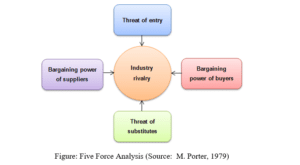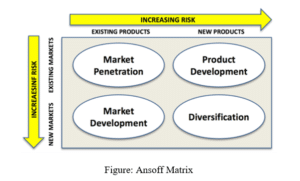HI6006 Strategic Development Tools Assignment Sample
Here’s the best sample of HI6006 Strategic Development Tools Assignment, written by the expert.
Introduction
In order to achieve success in this competitive environment, it is necessary for a firm to focus on an effective strategy. This study has focused on the different strategic development tools that are helpful for an organization to achieve success. There are a number of strategies are available to achieve the success in this competitive environment such as PESTEL analysis, SWOT analysis, Boston Matrix, Ansoff Matrix, Five force analysis, Resource-based view, generic strategies, Ghemawat`s AAA framework, etc.
PESTEL analysis
Environmental analysis is an effective strategic development tool for an organization. In concern of this, most of the organization focuses on the PESTEL analysis to identify and analyze areas of success where the macro-environmental factors are analyzed and monitored by the marketers that can impact on the organization (Gürel and Tat, 2017). The results of this analysis are used to identify the strengths, weaknesses, opportunity, and threats of the organization.
| Factors | Impacts |
| Political | Ø Support for a democratic and foreign government
Ø The regulatory environment and Political stability Ø Labor and human rights and Foreign trade regulation Ø Bilateral relations |
| Economic | Ø Monetary regulation and exchange rate currency
Ø Business cycle, GSP growth, and Tax & inflection rates Ø Unemployment, Social affinities, and social organizations Ø House income |
| Social | Ø Social affinities and social organizations
Ø Disposable Income and Population demographics Ø Religious influence and Education level Ø Change in lifestyle and Work Aptitude (Rothaermel, 2015) |
| Technological | Ø IP protection, ICT infrastructure, and Innovation cost
Ø Skilled labor and Costs of data movements |
| Environmental | Ø Waste management system and Renewable energy
Ø Green initiatives and Climate change strategy Ø ISO or Leeds certifications |
| Legal | Ø Level of democracy, Employment, and professional standard
Ø Labor Law, Legal system and Terms of employability |
These factors and its impacts are helpful for the organization to develop an effective strategy to achieve organizational objectives such as Wal-Mart has developed and PESTEL analyses before opening its stores in a different country.
SWOT analysis
This strategy is very important for an organization that identifies the competitive position of an organization by identifying the strengths, weaknesses, opportunities, and threats. Through this analysis, an organization can assess internal and external factors that impact on the position of the organization in the industry as well as it identifies the current and future potential (Agarwal et al., 2012).
The below table is representing the SWOT analysis of a business that can impact its decisions:
| Strengths
A company may have several strengths in their product, service and other such as: Ø Unique selling proposition Ø Competitive advantage Ø Organizational resources Ø What do customer like most in product Ø Staff members quality Ø Quality of assets |
Weaknesses
There are several weaknesses may have by an organization such as: Ø Need to improve specific areas of business Ø Lack of advantages Ø Lack of competitive position Ø The disadvantage of the worker or product quality (Jenkins and Williamson, 2015) Ø An internal factor that affects business success
|
| Opportunities
An organization can take advantage of several opportunities in the business environment such as : Ø Take advantage of the economic and political climate Ø The effective external factor for business Ø Use of market fluctuation Ø Taking advantage of a temporary nature
|
Threats
A business organization also have several threats in the business environment that can impact the business: Ø Number of competitors Ø Potentially dangerous market area Ø Innovation and technological changes in product Ø Changing trend of the market |
The above SWOT analysis is representing that a business needs to focus on both internal and external factor to make an effective decision. In concern of this, it can also be said that the SWOT analysis is helpful to provide a realistic, data-driven, and fact-based look of an organization or an industry (Milhem et al., 2014). For example, Swiggy always uses SWOT analysis to identify the market and establish the business into a new market.
Five force analysis
The five force model was developed by M. Porter in 1979 to understand the forces that affect the industry. The below figure is representing the five forces that impact an industry.

This tool is very valuable to formulate a strategy for a firm that reveals how each of the five key forces is powerful in a particular industry.
- The threat of new entrants– This force is helpful to determine how easy or not to enter into a particular industry.
- Bargaining power of suppliers– This force is helpful to find out how much the firm has the capacity to reduce the cost of material.
- Bargaining power of buyers– This force is useful to identify the capacity of the customer to reduce the price of the product by impacting on demand (Shvindina and Shkurko, 2015).
- The threat of substitutes– This force is helpful to identify the threats due to the availability of substitute products that can switch the loyal customer.
- Rivalry among existing competitors– This force determines how much the industry is competitive and profitable for a particular organization.
In order to use this tool, the organizational management needs to gather the information on each force and then the collected information should be analyzed the results as well as display it in the diagram. Finally, the strategy will be formulated on the basis of the conclusion (Grant, 2016). For example, Apple has analyzed the five forces to increase sales by introducing iTunes as a complement iPod that helped the company to add value for both products. As a result, the sales of iTunes have increased as well as an improved profit of Apple.
Ansoff Matrix
Ansoff Matrix is a tool that is used by a firm for analyzing and planning the strategies for growth. This tool includes four strategies to grow and analyze the risk area associated with each of the strategies (Daidj, 2014). Due to this, it is also called as Product/Market Expansion Grid that includes the below strategies:

- Market Penetration: This is an effective strategy that is used by an organizational to increase the overall sales of its existing products into its existing market. In concern to market penetration, a firm can reduce the price of the product, use the acquisition of a rival in the same market, enhance the promotion, refinements of modest product, etc. However, it can be said that the aim of this strategy to increase the market share of the company.
- Product Development: In this strategy, the organization needs to introduce a new product of the company in the existing market to increase their sales and revenue. The company targets its existing customers to sell their new products for enhancing the profitability by using existing brand’s strengths (Nartisa et al., 2012).
- Market Development: Through this strategy, an organization can grow by introducing their products and services in a new market. However, it can be said that this strategy focuses on the entrance of the company into a new market using existing products. If the core competencies of a firm are related highly to the specific product then its market segment experience.
- Diversification: This strategy is highly risky for an organization because this strategy focuses on the entrance into a new market by introducing new products to the customers.
A number of organizations focus on different strategies to grow their market but some of these strategies might be failed like Microsoft has introduced their mobile phones.
References
Gürel, E. and Tat, M., 2017. SWOT ANALYSIS: A THEORETICAL REVIEW. Journal of International Social Research, 10(51).
Rothaermel, F.T., 2015. Strategic management. McGraw-Hill Education.
Agarwal, R., Grassl, W. and Pahl, J., 2012. Meta-SWOT: introducing a new strategic planning tool. Journal of Business Strategy, 33(2), pp.12-21.
Grant, R.M., 2016. Contemporary strategy analysis: Text and cases edition. John Wiley & Sons.
Nartisa, I., Putans, R. and Muravska, T., 2012. STRATEGIC PLANNING AND MANAGEMENT IN PUBLIC AND PRIVATE SECTOR ORGANIZATIONS IN EUROPE: COMPARATIVE ANALYSIS AND OPPORTUNITIES FOR IMPROVEMENT. European integration studies, (6).
Daidj, N. ed., 2014. Developing strategic business models and competitive advantage in the digital sector. IGI Global.
Shvindina, H.O. and Shkurko, I.I., 2015. Development of the Quantitative Five Forces Analysis as a Strategic Management Tool.
Jenkins, W. and Williamson, D., 2015. Strategic management and business analysis. Routledge.
________________________________________________________________________________
Know more about UniqueSubmission’s other writing services:


Wow amazing blog layout How long have you been blogging for you made blogging look easy The overall look of your web site is magnificent as well as the content
Normally I do not read article on blogs however I would like to say that this writeup very forced me to try and do so Your writing style has been amazed me Thanks quite great post
Just wish to say your article is as surprising The clearness in your post is just cool and i could assume youre an expert on this subject Fine with your permission allow me to grab your RSS feed to keep updated with forthcoming post Thanks a million and please keep up the enjoyable work